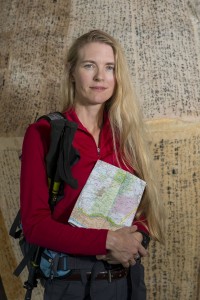This year, Columbia Riverkeeper member Ceiridwen Terrill traveled to Japan for commemoration ceremonies marking the 70th
anniversary of the atomic bombings of Hiroshima and Nagasaki. There she had the opportunity to participate in a pilgrimage to the Peace Park that began at Urakami Cathedral near the Nagasaki bomb site. She also gathered the stories of hibakusha, bomb survivors like Sakue Shimohira who was 11 years old at the time of the bombing. Shimohira recounted, “Glowing red on the scorched field, fires burning the people. My mother, too, went up in red flames. My sister, too, went up in red flames. And only a few ashes remained.” In an effort to share these and other stories, Terrill plans to walk from Portland to Hanford, and Riverkeeper welcomes you to meet her on her journey from 6-8 p.m. Sunday, October 11 at the While Salmon Public Library. This is a unique opportunity to learn about Hanford, Ceiridwen’s family history, her experiences in Japan, and why we should be fighting for a more thorough Hanford cleanup. We’ll also be showing our recently completed short film “Hanford, A Race Against Time."
EVENT DETAILS:
- What: Storytelling, Gathering, Short Film: Pizza, snacks and beverages will be provided.
- When: Sunday, October 11, 2015, at 6-8pm
- Where: White Salmon Public Library located at 77 NE Wauna Avenue, White Salmon, WA
Terrill’s inspiration to travel to Japan stemmed from her own family’s loss related to the atomic bomb. During the 1950s Terrill’s grandfather, an Oklahoma tenant farmer and pipefitter, uprooted the family to work at the Hanford Nuclear Reservation in southeastern Washington. Promises of a stable government job and security for his family quickly faded when he died at a young age. His youngest son, Terrill’s father, would also die young at the age of 31 of Hodgkin’s Lymphoma. In a phone interview, Ceiridwen explained, “I was planning to go to Japan for a while. I needed to see the site where Fat Man exploded. I wanted to know what Japanese survivors think about the bombing … how their feelings have changed over the years. Do they hold resentment? Having had a family that was essentially destroyed by Hanford, it was closing the loop by going to Japan and seeing these people who were so changed by the bomb that Hanford produced.”
Now, Terrill’s experience and the stories she heard in Japan are inspiring her to help raise awareness about our nation’s atomic legacy. Our own nuclear neighbor, the Hanford site on the Columbia River in Washington, produced plutonium that fueled the “Fat Man” bomb that killed tens of thousands of people in Nagasaki, Japan, on August 9, 1945. From October 9 to 18, Terrill will walk 225 miles from Portland to the Hanford Nuclear Reservation to celebrate peace and help others learn about our nation’s most contaminated site. Much of her route will be along the Columbia River.
Like the hibakusha, who are worried their stories will be forgotten, Terrill too worries that the next generations will forget about Hanford. “If Hanford cleanup doesn’t go well, we could have a terrible disaster in the region. We need to clean up this place in a way that is manageable. And people aren’t paying attention in our region, and we need to be. Hanford is so close, 225 miles is not far for waste to travel. If I can walk there, the waste can come here. I just don’t see enough awareness in the public and this is something small I can do.” Anyone is welcome to join her for all or part of her walk.
Help us follow Ceiridwen on Instagram and Twitter @1ceiridwen using #peaceORbust. View her walking route here http://www.cu-portland.edu/news/concordia-professor-walks-peace.
About Ceiridwen Terrill
Dr. Ceiridwen Terrill is a professor of English at Portland’s Concordia University, where she teaches environmental journalism, science writing, and memoir. Her special interests include urban ecology, urban/wild conflicts, and the connections among gender, culture, and science. Terrill teaches field courses in botanical medicine and urban ecology, and is currently working on a book about growing up during the Cold War and her family’s connection to the Hanford Nuclear Reservation. She has authored two memoirs/scientific studies: Part Wild (Scribner), which was a finalist for the 2013 Oregon Book Award, and Unnatural Landscapes: Tracking Invasive Species (University of Arizona Press).
About Hanford
The Hanford Nuclear Reservation is a 586-square-mile former military site located in southeastern Washington near the Tri-Cities of Richland, Pasco, and Kennewick. At Hanford, our nation produced plutonium for atomic weapons during WWII and throughout the Cold War. Today, chemical and radioactive pollution left behind from decades of plutonium production continues to threaten the Columbia River, downstream communities, and worker health.
This product was funded through a grant from the Washington Department of Ecology. While these materials were reviewed for grant consistency, this does not necessarily constitute endorsement by the Department.



